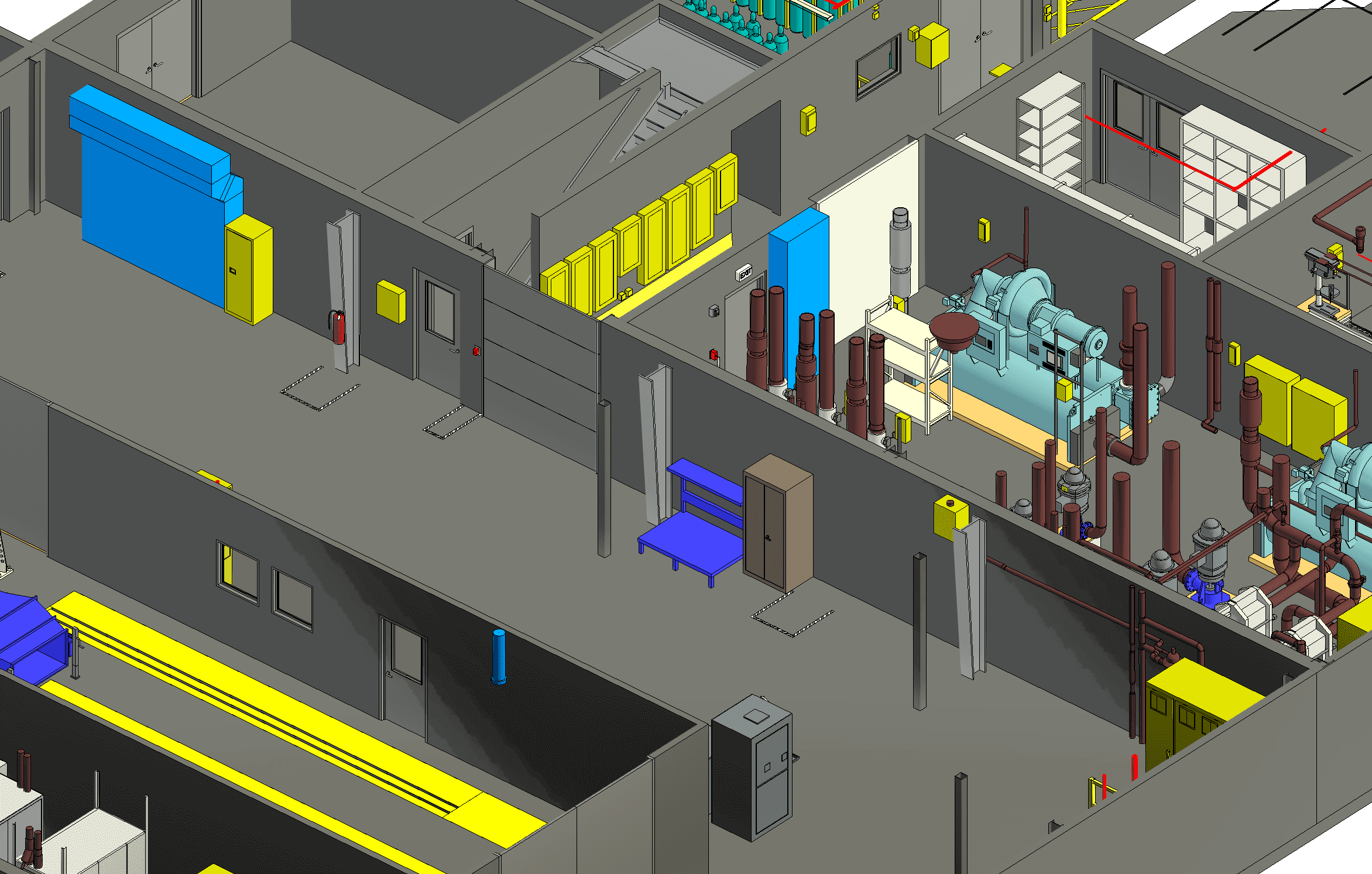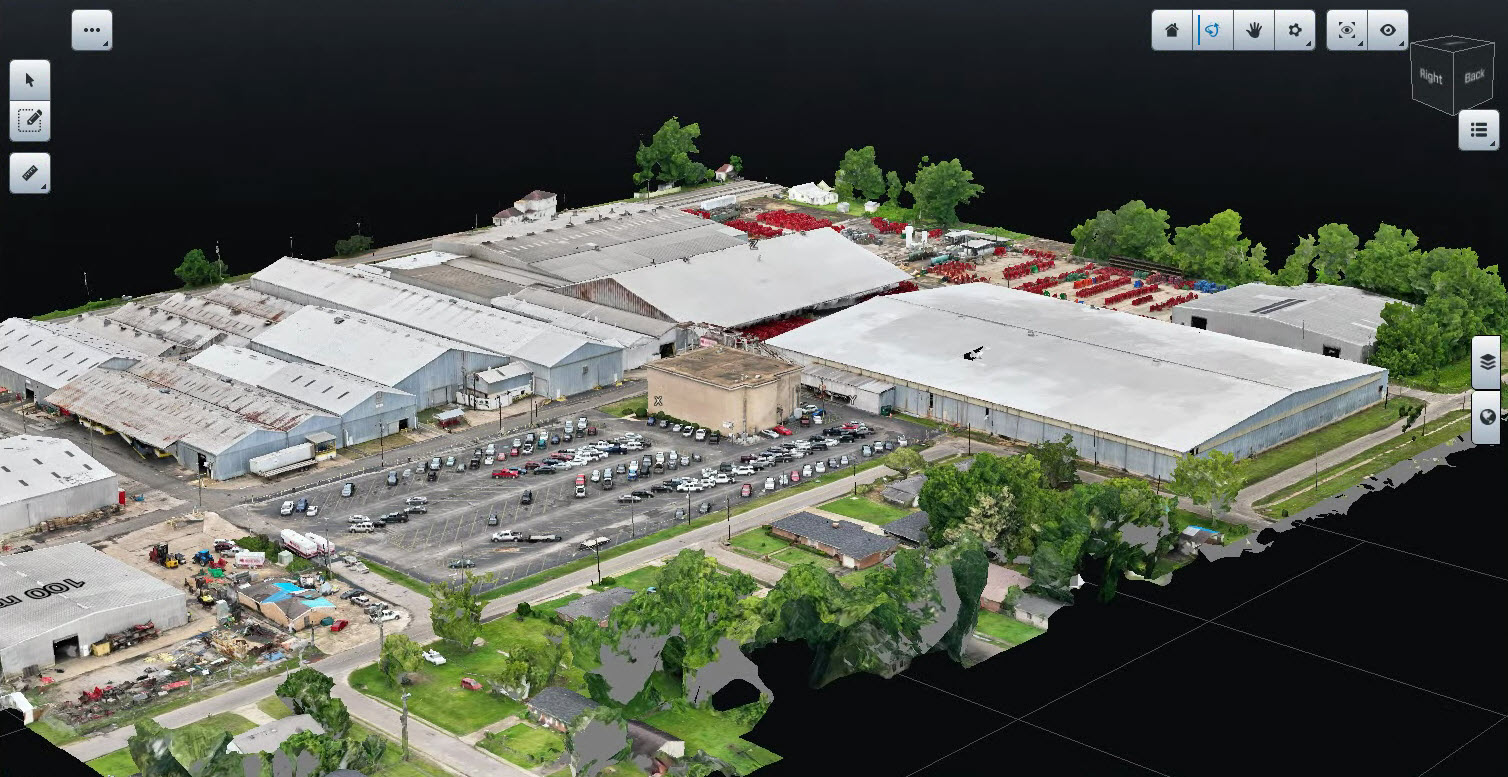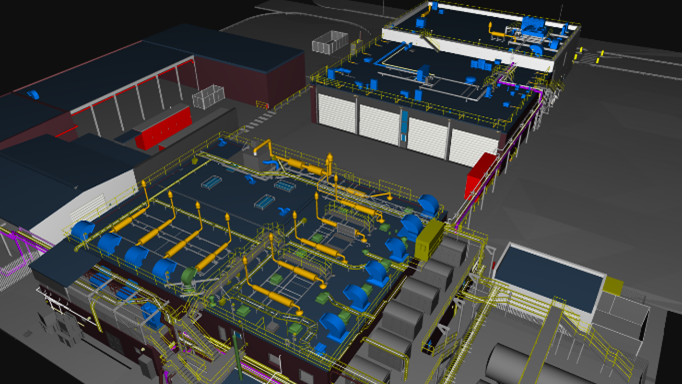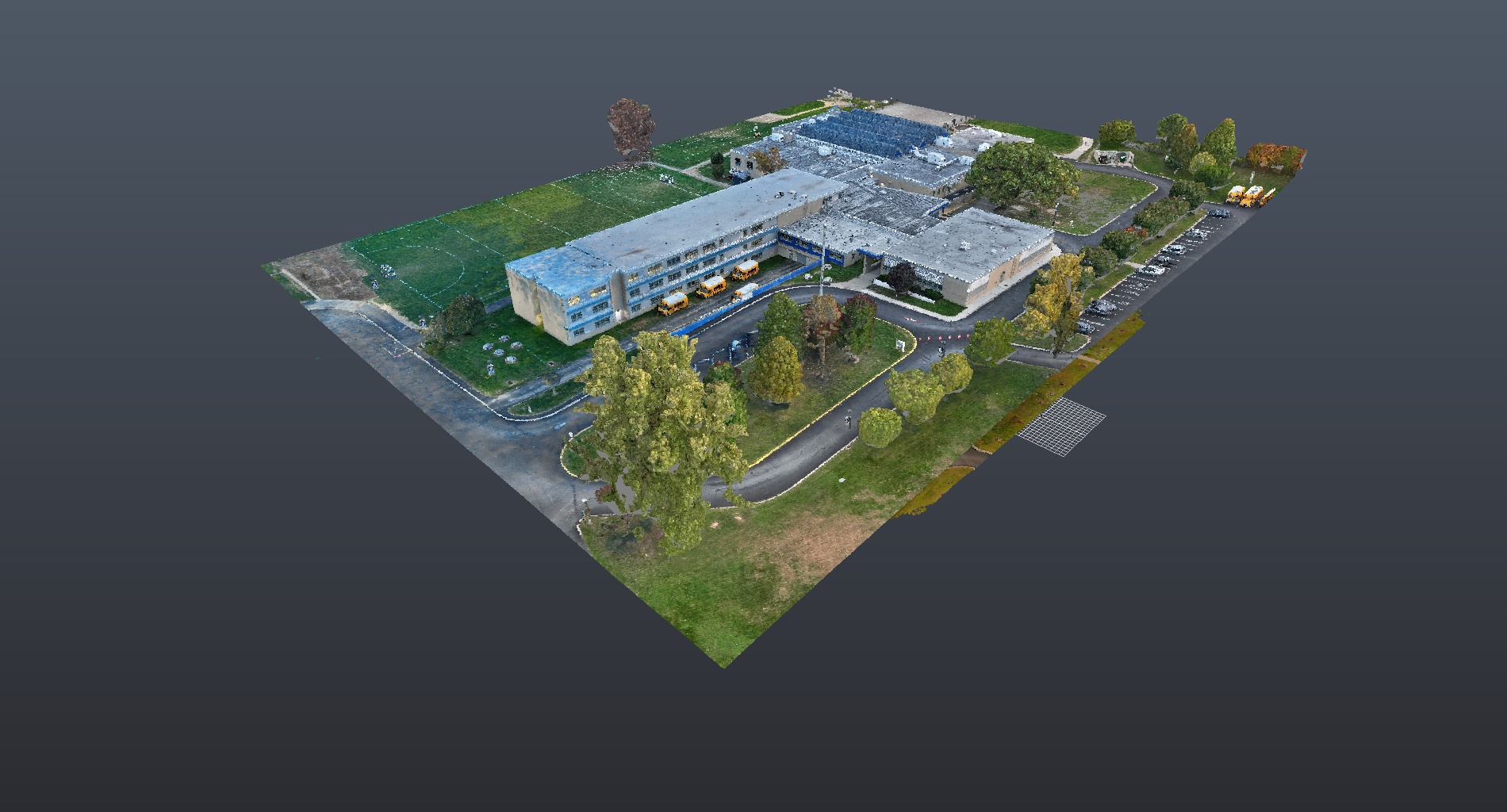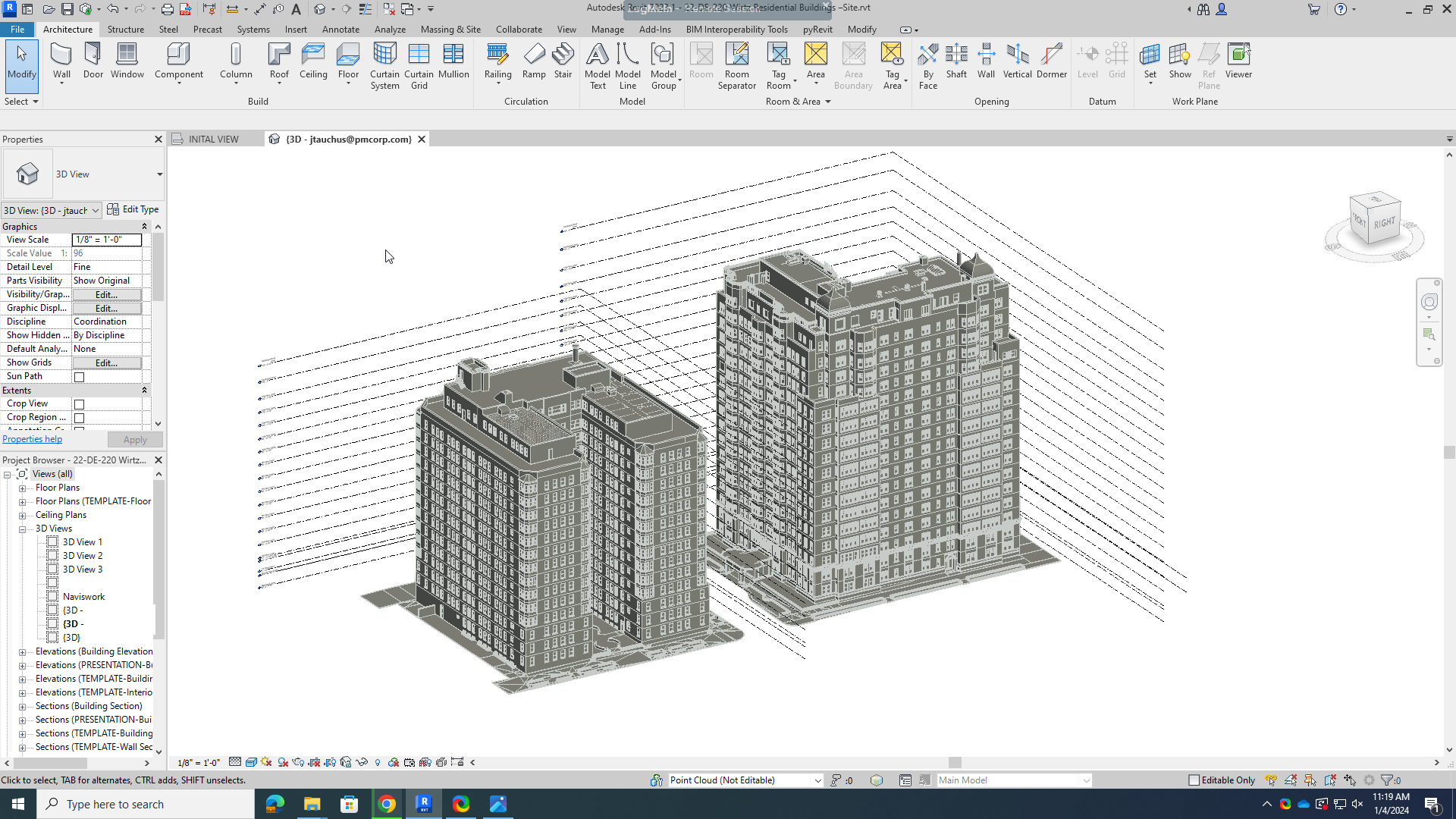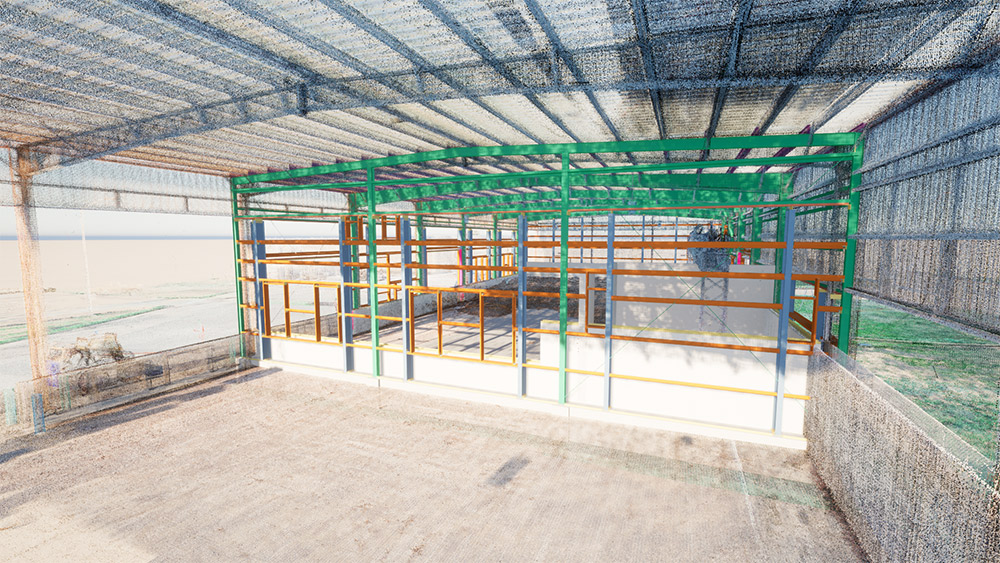Improving the Manufacture of Extruded Window Seals Via Simulation
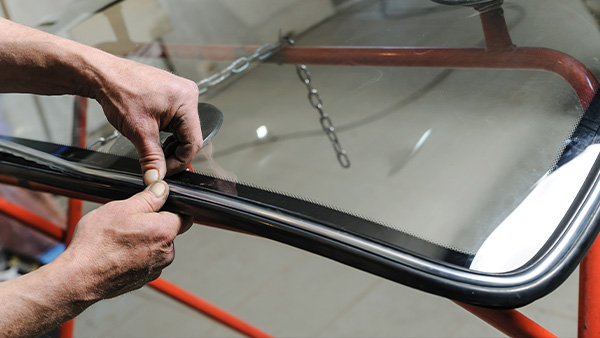
Marcelo Zottolo
Edward Williams
Production Modeling Corporation
Suite 1006 Parklane Towers West
Three Parklane Boulevard
Dearborn, Michigan 48126 U.S.A.
{mzottolo|ewilliams}@pmcorp.com
KEYWORDS
Manufacturing simulation, scenario analysis.
ABSTRACT
Discrete-event process simulation, which boasts a long and enviable history of guiding improvements to manufacturing operations, extended its successes in the study reported here. A small manufacturer of extruded window seals, as a member of the automotive industry supply chain, used discrete-event simulation and allied statistical input and output analyses to comparatively evaluate four alternatives and select the best one based on various performance metrics and business scenarios.
INTRODUCTION
Discrete-event process simulation has helped improve efficiency and economy of operations in many fields, such as manufacturing, healthcare, service, transportation, and logistics; among these, manufacturing applications are the most venerable and perhaps still the most numerous (Miller and Pegden 2000). Examples of such studies in the literature are numerous. For example, (Giribone, Mosca, and Queirolo 2003) applies simulation to validation of weekly production plans. (Palacis 2003) describes the application of simulation to integrate systems, both vertically and horizontally, to operations such as planning, soaking, sorting, and kiln-drying in the lumber industry. (Carpanzano and Cataldo) 2003 applies simulation to verify logic controls for agile manufacture of shoes. Again, within the automotive industry’s far-reaching supply chains, (Türkseven and Ertek 2003) uses simulation to improve both the quality and the efficiency of manufacturing steel cord used to fabricate radial tires. In the current study, a supplier of automotive parts teamed with an industrial engineering consulting company to conduct a study which provided the supplier with valuable information concerning performance metrics under each of four scenarios.
To describe this study, the authors will first provide a descriptive overview of the manufacturing process, emphasizing the questions and concerns which collectively urged the client to seek both strategic and tactical guidance from a process-simulation analysis. After a description of the construction, verification, and validation of the model, this paper will then present the results of the study for the various scenarios considered and summarize the results and their implications for future analogous studies.
OVERVIEW OF MANUFACTURING PROCESS AND ITS CONCERNS
The client in question manufactures rubber window seals for trucks ultimately sold to private consumers (not overland trucking companies) by a large automotive manufacturer. These seals are made in six varieties: left-hand versus right -hand, and front-window (“quad” or standard) versus rear-window. Hence, in terminology typical to the economic region surrounding Detroit, Michigan, United States, the client is a “first tier automotive supplier.” Specifically, the production line wherein this client sought guidance and improvement via simulation analyses was an extrusion line; extrusion being a generic term for a manufacturing process in which a billet of raw material (rubber in this case), enclosed in a container, is forced through an aperture whose cross sectional area and dimensions are smaller than those of the original billet (El Wakil 1998). After extruding raw generic lengths of outer belt seals and cutting them to specified lengths, the manufacturing process must first send them to a work-in-process [WIP] cooling area, where they cool for at least one hour in a water quench bath before application of glue, attachment of flock (soft fuzzy material) to the glue, and cutting to length pertinent to the variety currently being produced. Production is in batch mode – i.e., only one product variety (length) is in production in this line at any particular time. The parts are then transported to assembly machines which punch them and assemble end caps automatically. These assembly machines then disgorge the assembled parts to an inspection area. There, an operator inspects them and packs satisfactory ones in containers for shipment.
Specific performance metrics of high concern were WIP level, safety-stock levels, throughput, and order-to-delivery elapsed time under a variety of demand scenarios. Client management knew from experience with the highly volatile consumer truck market that some safety stock needed to be kept in inventory, despite the associated carrying costs, as a hedge against sudden high urgency demands from their key customer, the automotive manufacturer. Since these managers held discretionary decision-making authority over numerous parameters: line speeds, cycle times, number of
operators, number and length of work shifts, etc., they specified that the simulation model be able to explore alternatives pertinent to all of these. In particular, they faced impending highly committal decisions involving both facility reconfiguration to accommodate huge machines and WIP storage areas, and the potential hiring of additional production employees.
Additionally, the client engineers had advocated use of simulation at their company previously; this study represented the first budgetary approval of its use. Therefore, it was important to them to achieve a conspicuous success with this project to establish a beachhead for ongoing beneficial use of simulation within the company (Williams 1997). In this context, “conspicuous success” explicitly included strict adherence to stern budgetary constraints on both financial and time expenditures.
MODEL CONSTRUCTION, VERIFICATION, AND VALIDATION
Having decided on the scope of the model and analysis (the batch-mode extrusion line), client engineers and the simulation analysts next collaborated to specify fundamentals of model construction. For example, the production schedule used for the base model comprised four 24-hour days per week, in three shifts (7am to 3pm, 3pm to 11pm, and 11pm to 7am). Each shift included two breaks of fifteen minutes each, and operators were assumed always available except during those breaks. Likewise, raw material was assumed always available. Shipment of completed work (hence vacating output WIP areas) occurred daily at noon. Animation would be two-dimensional only. As simulation experts have repeatedly remarked (Sadowski 1991), documentation and mutual (client -analyst) understanding and acceptance of assumptions such as these is essential, lest the client unwittingly misuse, misinterpret, or unjustifiably extrapolate results later obtained from the model. Only after these mutual understandings are firmly in place can a simulation model hope to achieve credibility – the willingness of client managers to base economically high-stake decisions upon the results of the model (Law and Kelton 2000).
Next, the client engineers and consulting analysts discussed the simulation software of choice; the discussions incorporated many of the ideas and methods recommended in (Tewolde Berhan et al. 2002). In view of the fiscal constraints pertaining to the study, the absence of need to model detailed material-handling systems (such as, for example, fleets of automatic guided vehicles), and the acceptability of two-dimensional animation, the project team agreed upon the use of SIMUL8® software. This software package and simulation tool permits simultaneous construction of a model and its two dimensional animation, and provides basic constructs such as Work Centers, Storages (buffers and/or queues), Resources (e.g., machine operators or special pieces of equipment), Conveyors, Work Entry Points, and Work Exit Points (Hauge and Paige 2001). One unexpected difficulty in building the model was the difficulty of representing two distinct shift patterns for the facility – one for weekdays and another for weekends. It is straightforward in SIMUL8® to specify a shift pattern to control availability of resources, and also to specify that a shift pattern controls only a specified subset of days of the week. However, there is no canonical way of defining two contrasting shift patterns and transferring “control” from either to the other as the simulation clock advances among the days of the week. The modeling team overcame this difficulty by defining a shift pattern for the weekdays and then writing code in Visual Logic (SIMUL8®’s internal programming language) to control resource availability on weekends. An additional limitation of SIMUL8® is its inability to distinguish, in its reports of performance statistics, whether a work center is on- or off shift. For example, if a work center is idle when it goes off shift, the off-shift time is reported as idle time; if a work center is busy when it goes off-shift, the off-shift time is reported as busy time. This hindrance to precise interpretation of output statistics relative to machine utilization was overcome by a small amount of Visual Logic coding within the model plus routine computations “downstream” within the Excel® worksheets receiving SIMUL8® output.
Construction of the model incorporated, in addition to the basic process flow through a variety of operations, downtimes, setup times, and usage of labor, including shift patterns. The model construction proceeded concurrently with gathering of additional data, such as downtime data, by the client engineers. In view of uncertainties acknowledged relative to many of these data, the engineers and analysts agreed that (a) extensive sensitivity analyses would be undertaken, and (b) input data parameters would be extensively incorporated into a spreadsheet which client engineers could conveniently revise during experimentation. In particular, the availability of the inventory level, updated in “real simulation time” within an Excel® worksheet as the model ran, provided an unexpected nicety of high value to the client engineers and their managers. Model verification and validation techniques used included exhaustive examination of the animation (a screenshot of which appears in Figure 1 on the last page of this paper), structured walkthroughs, extreme condition tests (for example, an experimental run in which no or all parts are rejected at an inspection point), examination of stepwise model traces, and Turing tests (Sargent 2003). Significantly, team meetings involved not only client engineers, but also their managers – a team effort vital to the credibility of the simulation and the eventual incorporation of its results into client operational practice (Scheeres 2003).
RESULTS OF THE STUDY
Four different scenarios, summarized in Table 1 on the next page, were run for comparative analysis.
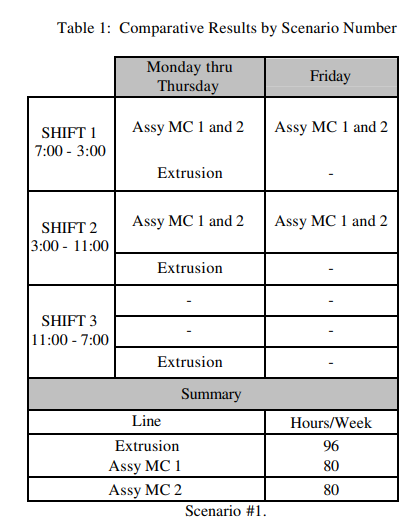
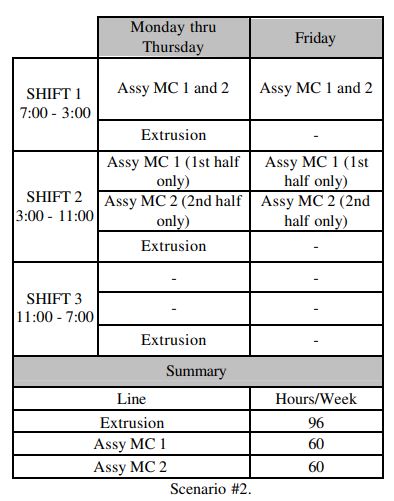
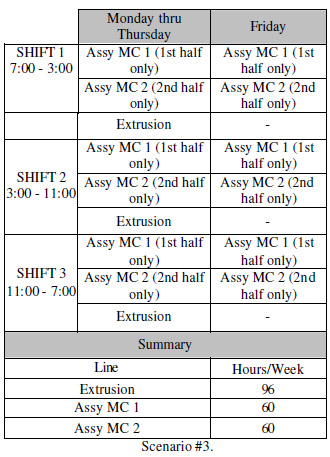
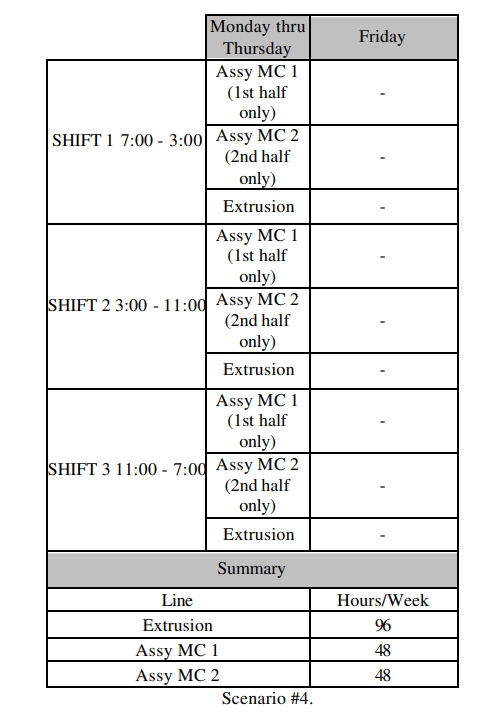
Each scenario was run with a warm-up of 220 hours, a run length of 960 hours, and three replications. The long warm -up and run times were attributable to the rare but significantly long equipment downtimes in the model; achieving steady state and obtaining representative results within each replication depended on allowing each downtime to occur at least five or six times (Harrell and Tumay 1995). In contrast, the low number of replications was attributable to the relatively small amounts of stochastic variation within the model. Cycle times were fixed; the only variability in the model appeared in the rarely used breakdown parameters (time to failure and time to repair).
For Scenario #1, key results were:
[1] Based on stated assumptions, demand can be fully satisfied.
[2] Overall, assembly crews (two for each of shifts one and two) are 23% idle due to lack of work-in process (WIP) seals to process.
[3] Daily, the second shift starts with the work-in process (WIP) area nearly empty.
[4] The extrusion line paces the system and ass Embly crews are busy half of the shift.
For Scenarios #2 and #3, key results were:
[1] Based on stated assumptions, demand can be fully satisfied.
[2] WIP area runs out of seals by Friday at the beginning of the second shift, implying no assembly production during the second shift (Scenario #2) or during both the second and third shifts (Scenario #3).
[3] Assembly lines are idle approximately 8% of the time.
[4] Scenario #3 has less average WIP inventory than does Scenario #2.
[5] Since production exceeds demand, the finished seals inventory grows without an endogenous bound.
For Scenario #4, key results were:
[1] Based on stated assumptions, demand can be fully satisfied.
[2] The WIP area never runs out of parts; therefore, both assembly lines always have WIP seals to process and their idle time is zero.
[3] Since production exceeds demand, the finished seals inventory grows without an endogenous bound. However, maximum levels of WIP reached are lower than those of either Scenario #2 or Scenario #3.
SUMMARY AND CONCLUSIONS
At project inception, the optimum choice of analytical tool(s) to solve the client’s problem was quite unclear; the natural candidates were basic spreadsheet (Excel®) analysis, use of a discrete-event process simulation tool, and/or use of scheduling analysis. Initial discussions with the client exposed the tacit assumption that schedules would change infrequently – at least within the near-term time frame (approximately one calendar quarter) within which the clients and their managers were eager to obtain efficiency improvements. Therefore, the possibility of using scheduling analysis and its software tools were set aside for potential later use; indeed, such analysis is now a likely aftermath of the work described in this paper. The sheer problem complexity defied the possibility of using spreadsheet analyses alone; rather, spreadsheets were used, as noted above, as a convenient milieu for data input and results output from discrete-event simulation. The clients and their managers, well satisfied with the timeliness and unequivocal results of this simulation study, used it as a basis for deciding among the four scenarios presented above. Specifically, they fixed upon Scenario #4, which, like the first three scenarios, satisfied market demand and additionally offered the following advantages:
a) The assembly lines were never idle.
b) The work-in-process area never suffered stockouts.
c) Due to better balancing of labor resources between the extrusion and assembly departments, no more crews were necessary – a significant economic advantage.
Furthermore, this successful application of simulation in this business environment originally having little familiarity with it has increased the likelihood of its future use as an analytical tool within the client company.
ACKNOWLEDGMENTS
The authors gratefully acknowledge the assistance of Rohit Trivedi, a professional colleague and educator in simulation (the latter at Wayne State University, Detroit, Michigan, United States) in suggesting improvements to this paper. Additionally, the authors are pleased to acknowledge the constructive and helpful criticisms of an anonymous referee.
REFERENCES
Carpanzano, Emanuele, and Andrea Cataldo. 2003. Modular Design and Simulation Based Verification of the Logic Control Code for an Agile Shoe Manufacturing System. In Proceedings of the 2003 Industrial Simulation Conference, eds. Juan Carlos Guerri, Ana Pajares, and Carlos Palau, 290-294.
El Wakil, Sherif D. 1998. Processes and Design for Manufacturing, 2nd edition. Boston, Massachusetts: PWS Publishing Company.
Giribone, Pietro, Roberto Mosca, and Filippo Queirolo. 2003. Validating the Production Weekly Plan by Scheduling Simulation. In Proceedings of the 15th European Simulation Symposium, eds. Alexander Verbraeck and Vlatka Hlupic, 332-336.
Harrell, Charles, and Kerim Tumay. 1995. Simulation Made Easy: A Manager’s Guide. Norcross, Georgia: Engineering & Management Press.
Hauge, Jaret W., and Kerrie N. Paige. 2001. Learning SIMUL8: The Complete Guide. Bellingham, Washington: PlainVu Publishers.
Law, Averill M., and W. David Kelton. 2000. Simulation Modeling and Analysis, 3rd edition. Boston, Massachusetts: The McGraw-Hill Companies, Incorporated.
Miller, Scott, and Dennis Pegden. 2000. Introduction to Manufacturing Simulation. In Proceedings of the 2000 Winter Simulation Conference, Volume 1, eds. Jeffrey A. Joines,Russell R. Barton, Keebom Kang, and Paul A. Fishwick, 63-66.
Palacis, Edgars. 2003. Wood Production Industry: Integrated Systems Approach and Applications. In Proceedings of the International Workshop on Harbour, Maritime and Multimodal Logistics Modelling & Simulation 2003, eds. Yuri Merkuryev, Agostino G. Bruzzone, Galina Merkuryeva, Leonid Novitsky, and Edward Williams, 167-169.
Sadowski, Randall P. 1991. Avoiding the Problems and Pitfalls in Simulation. In Proceedings of the 1991 Winter Simulation Conference, eds. Barry L. Nelson, W. David Kelton, and Gordon M. Clark, 48-55.
Sargent, Robert B. 2003. Verification and Validation of Simulation Models. In Proceedings of the 2003 Winter Simulation Conference, Volume 1, eds. Stephen E. Chick, Paul J. Sánchez, David Ferrin, and Douglas J. Morrice, 37-48.Scheeres, Junell. 2003. Making Simulation a Reality. Industrial Engineer 35(2):46-48.
Tewoldeberhan, Tamrat W., Alexander Verbraeck, Edwin Valentin, and Gilles Bardonnet. 2002. An Evaluation and Selection Methodology for Discrete-Event Simulation Software. In Proceedings of the 2002 Winter Simulation Conference, Volume 1, eds. Enver Yücesan, Chun -Hung Chen, Jane L. Snowdon, and John M. Charnes, 67-75.
Türkseven, Can Hulusi, and Gürdal Ertek. Simulation Modeling for Quality and Productivity in Steel Cord Manufacturing. In Proceedings of the 2003 Winter Simulation Conference, Volume 2, eds. Stephen E. Chick, Paul J. Sánchez, David Ferrin, and Douglas J. Morrice, 1225-1229.
Williams, Edward J. 1997. How Simulation Gains Acceptance as a Manufacturing Productivity Improvement Tool. In Proceedings of the 11th European Simulation Multiconference,eds. Ali Riza Kaylan and Axel Lehmann, P-3 – P-7.
AUTHOR BIOGRAPHIES
EDWARD J. WILLIAMS holds bachelor’s and master’s degrees in mathematics (Michigan State University, 1967; University of Wisconsin, 1968). From 1969 to 1971, he did statistical programming and analysis of biomedical data at Walter Reed Army Hospital, Washington, D.C. He joined Ford Motor Company in 1972, where he worked until retirement in December 2001 as a computer software analyst supporting statistical and simulation software. After retirement from Ford, he joined Production Modeling Corporation, Dearborn, Michigan, as a senior simulation analyst. Also, since 1980, he has taught classes at the University of Michigan, including both undergraduate and graduate simulation classes using GPSS/H, SLAM II, SIMAN, Promodel, SIMUL8, or Arena®. He is a member of the Institute of Industrial Engineers [IIE], the Society for Computer Simulation International [SCS], and the Michigan Simulation Users Group [MSUG]. He serves on the editorial board of the International Journal of Industrial Engineering – Applications and Practice. During the last several years, he has given invited plenary addresses on simulation and statistics at conferences in Monterrey, México; Istanbul, Turkey; Genova, Italy; and Riga, Latvia. He served as a co-editor of Proceedings of the International Workshop on Harbour, Maritime and Multimodal Logistics Modelling & Simulation 2003, a conference held in Riga, Latvia. His email address is [email protected]
MARCELO ZOTTOLO, born in Buenos Aires, Argentina, came to the United States to finish his college studies. He was graduated from the University of Michigan Dearborn as an Industrial and Systems Engineer in December 2000. He was awarded the Class Honors distinction and his Senior Design Project was nominated for the Senior Design Competition 2001. This project studied the improvement of manufacturing processes for the fabrication of automotive wire harnesses, ultimately proposing an automation tool leading to improvements in future designs. Additionally, he was co-author of a paper on simulation in a distribution system which earned a “best paper” award at the Harbour, Maritime, and Simulation Logistics conference held in Marseille, France, in 2001. He is currently working for Production Modeling Corporation as a Simulation Engineer. There, his responsibilities include building, verifying, validating, and analyzing simulation models in WITNESS® and SIMUL8® for large corporate clients; he also presents in-house training seminars. His email address is [email protected]

Figure 1: Typical Screenshot of SIMUL8® Animation.

Figure 2: Interactive Chart of Work-in-Process Inventory as Simulation Progresses.


